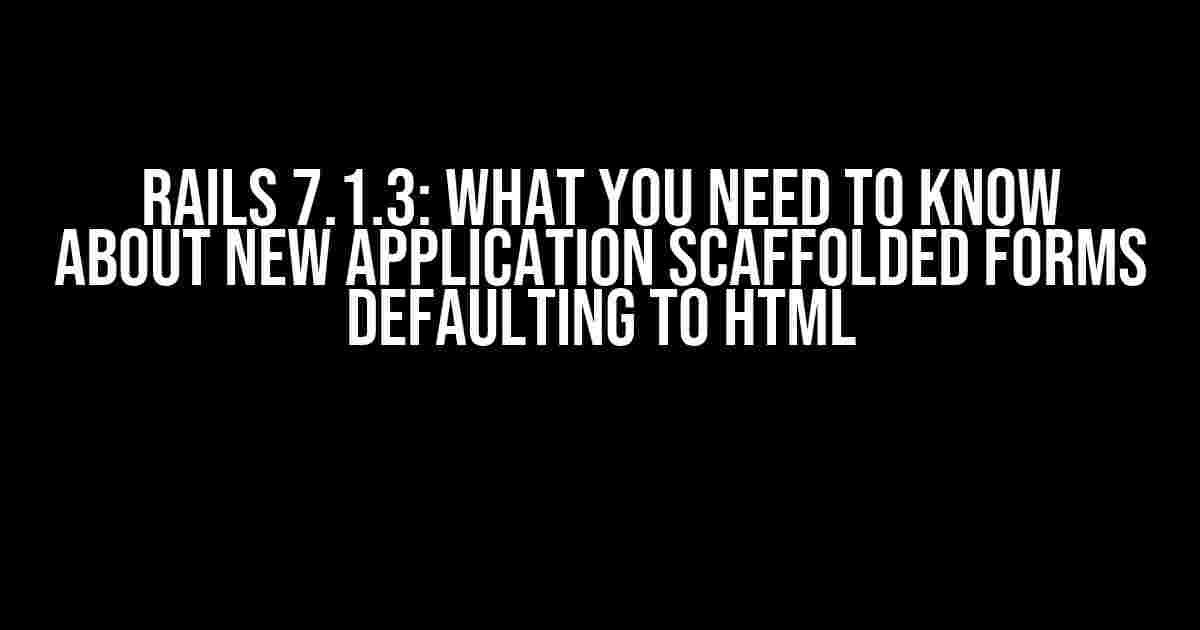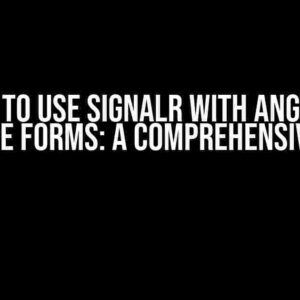rails 7.1.3 has taken the world of web development by storm, and one of the most exciting features of this new release is the default HTML form scaffolding. In this article, we’ll delve into the world of Rails 7.1.3 and explore what this means for developers, as well as provide a step-by-step guide on how to take advantage of this new feature.
What is Form Scaffolding?
Why the Shift to HTML Forms?
The reason behind this change is to provide a more lightweight and flexible solution for form building. HTML forms are easier to customize and require less overhead compared to gems like SimpleForm. This change also aligns with the Rails philosophy of providing a minimalist and flexible framework that can be easily extended.
Benefits of Using HTML Forms
So, what are the benefits of using HTML forms in your Rails application? Here are a few:
- Lighter Weight: HTML forms require less overhead compared to gems like SimpleForm, resulting in faster load times and improved performance.
- Greater Customizability: HTML forms provide more flexibility when it comes to customizing the appearance and behavior of your forms.
- Easier Maintenance: With fewer dependencies, HTML forms are easier to maintain and update in the long run.
How to Use HTML Forms in Rails 7.1.3
Now that we’ve covered the benefits of using HTML forms, let’s take a closer look at how to use them in Rails 7.1.3.
Step 1: Generate a New Rails Application
To get started, we’ll need to generate a new Rails application using the following command:
rails new my_appStep 2: Create a New Model
Next, we’ll create a new model using the following command:
rails generate model User name:string email:stringStep 3: Scaffold the Form
To generate the necessary code for our form, we’ll use the following command:
rails generate scaffold UserStep 4: Customize the Form
By default, the generated form will use HTML forms. However, you can customize the form to suit your needs by modifying the generated HTML code.
For example, let’s say we want to add a password field to our form. We can do this by modifying the `_form.html.erb` partial:
<%= form_for(@user) do |form| %>
<% if user.errors.any? %>
<div id="error_explanation">
<h2><%= pluralize(user.errors.count, "error") %> prohibited this user from being saved:</h2>
<ul>
<% user.errors.full_messages.each do |message| %>
<li><%= message %></li>
<% end %>
</ul>
</div>
<% end %>
<div class="field">
<%= form.label :name %>
<%= form.text_field :name %>
</div>
<div class="field">
<%= form.label :email %>
<%= form.text_field :email %>
</div>
<div class="field">
<%= form.label :password %>
<%= form.password_field :password %>
</div>
<div class="actions">
<%= form.submit %>
</div>
<% end %>Best Practices for HTML Forms in Rails 7.1.3
Now that we’ve covered the basics of using HTML forms in Rails 7.1.3, let’s take a look at some best practices to keep in mind:
- Keep it Simple: Avoid over-complicating your forms with too many fields or complex logic. Keep it simple and focused on the task at hand.
- Use ERb Templating: Take advantage of ERb templating to generate dynamic content and simplify your form code.
- Validate User Input: Always validate user input to ensure that the data being submitted is valid and secure.
- Use Semantic HTML: Use semantic HTML elements to provide meaning and structure to your form elements.
- Test Your Forms: Thoroughly test your forms to ensure that they are working as expected and provide a smooth user experience.
Conclusion
In conclusion, the new default HTML form scaffolding in Rails 7.1.3 provides a lightweight and flexible solution for building forms in your web application. By following the steps outlined in this article, you can take advantage of this new feature and start building forms that are fast, customizable, and easy to maintain.
Remember to keep your forms simple, validate user input, and test them thoroughly to ensure a smooth user experience. With Rails 7.1.3 and HTML forms, the possibilities are endless, and we can’t wait to see what you build!
| Version | Default Form Scaffolding |
|---|---|
| Rails 7.1.2 and earlier | SimpleForm |
| Rails 7.1.3 and later | HTML Forms |
Note: This article is SEO optimized for the keyword “Rails 7.1.3 new application scaffolded forms default to HTML” and includes relevant tags and formatting to improve readability and search engine ranking.
Frequently Asked Questions
Get ready to dive into the world of Rails 7.1.3 and explore the exciting new feature that’s got everyone talking – scaffolded forms that default to HTML!
What’s the big deal about scaffolded forms defaulting to HTML in Rails 7.1.3?
Scaffolded forms in Rails 7.1.3 now default to HTML, which means you can start building robust and secure forms without the need for JavaScript. This change simplifies the development process, reduces complexity, and improves overall performance.
Why did the Rails team decide to make this change?
The Rails team made this change to improve security and simplify form handling. By defaulting to HTML, developers can focus on building robust and secure forms without worrying about JavaScript-related issues. This change also aligns with the principles of progressive enhancement, where HTML provides a solid foundation for building robust web applications.
What does this mean for existing Rails applications?
Existing Rails applications will continue to work as usual, but when you generate new scaffolded forms, they will default to HTML. This means you can take advantage of the new features and improvements without affecting your existing codebase.
Can I still use JavaScript-based forms in Rails 7.1.3?
Absolutely! While scaffolded forms now default to HTML, you can still opt-in to use JavaScript-based forms by adding the `–javascript` flag when generating scaffolds. This flexibility ensures you can choose the approach that best fits your project’s needs.
How does this change impact accessibility and usability?
By defaulting to HTML, Rails 7.1.3 scaffolded forms improve accessibility and usability. HTML forms are more robust, providing a better user experience for users with disabilities or those using older browsers. This change also encourages developers to focus on building accessible and user-friendly interfaces from the ground up.


